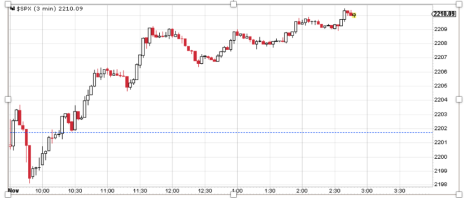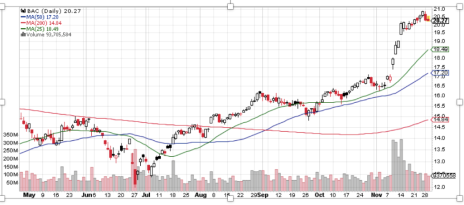On Tuesday morning, investors (particularly those invested in growth stocks) anxiously awaited news from the Commerce Department about U.S. Gross Domestic Product (GDP) in the third quarter. The GDP number, which represents the total value of all the goods and services produced by the economy as a whole, is considered the best single-number reflection of how fast the economy is growing.
Q3 GDP was initially reported at 2.9%, and stock investors were hoping that the revised number wouldn’t fall below that.
So when the number came in at 3.2%, there was some genuine applause from Wall Street. A 3.2% annualized expansion in GDP is real growth, and that reinforced everyone’s confidence that the U.S. Federal Reserve Board would indeed raise interest rates in December.
As you probably remember, the Fed wanted to get at least two rate hikes on the books in 2016, but the global economy kept making a mess of things. First there was a major correction in the Chinese stock market that raised worries of contagious weakness in the world’s second-largest economy.
[text_ad]
Then there was the Brexit surprise, which injected a major hit of uncertainty into forecasts of European growth.
With a 3.2% expansion rate to work with, the Fed will be quite happy to tick its prime rate up a quarter point, with a promise of more hikes in the new year if growth holds up. And while some people worry that any rate hike is a bad thing for the economy, it’s important to remember that rate hikes are a response to strong growth, and investors will generally agree with that logic.
So how did the market respond to the GDP news? Here’s a chart showing the S&P 500 Index’s action for November 29 in three-minute intervals. The GDP data were released just before the open, and you can see the little uptick at the open, the 12-minute dip just after, and then the enthusiastic response as investors digested the excellent number and the positive commentary that accompanied it.
The Commerce Department pointed out that the major contributors to the good growth number were 1) progress in the labor market (more people working and wages rising) and 2) household spending that matched or bettered estimates. Those two numbers more than counterbalanced the weakness in business investment.
For growth stock investors, getting evidence of a healthy economy is always welcome. When more money is changing hands, businesses are competing for slices of a bigger pie, increasing successful companies’ revenue growth and giving laggards more revenue to finance the changes they need to make to climb the ladder.
Ultimately, if the economy stays strong and stock markets remain robust, more young companies will come public and enter the competition for investors’ money.
Stock markets have been through a long, long dead spell, with equity mutual funds experiencing hundreds of billions of dollars of outflows as investors looked for safety and certainty. And when interest rates go up, it will raise the returns investors can get from genuinely safe investments (like Treasuries).
But higher rates will also be a huge boost for financial companies like banks, insurance companies and investment houses, whose returns depend on the money they can make with the enormous amount of client cash and reserves they hold. So those companies are also enjoying rising stock prices.
What does it look like when investors anticipate improved health for financial stocks? Here’s a daily chart for Bank of America (BAC), showing the rally that started in July and the acceleration of buying this month as the certainty of a December rate hike increased.
So, to make a long story short, that’s why growth stock investors should be very glad about Tuesday’s GDP numbers.
If you’d like to hear what Cabot Wealth Network has to say about the best growth stocks to buy to ride this wave, you can always find us at www.cabotwealth.com.


